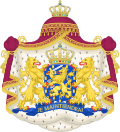
Back Nederlandse monargie Afrikaans الملكية في هولندا Arabic Нідэрландская манархія Byelorussian Reis dels Països Baixos Catalan Nizozemská monarchie Czech Μοναρχία των Κάτω Χωρών Greek Monarquía de los Países Bajos Spanish Madalmaade kuningas Estonian Alankomaiden hallitsija Finnish Monarchie néerlandaise French
This article has multiple issues. Please help improve it or discuss these issues on the talk page. (Learn how and when to remove these template messages)
|
| Monarch of of Kingdom of the Netherlands | |
|---|---|
| Koning der Nederlanden | |
 | |
| Incumbent | |
 | |
| Willem-Alexander since 30 April 2013 | |
| Details | |
| Style | His Majesty |
| Heir apparent | Catharina-Amalia, Princess of Orange |
| First monarch | William I |
| Formation | 16 March 1815 |
| Residence | |
| Website | www |
| Part of the Politics series |
![Azure, billetty Or a lion with a coronet Or armed and langued Gules holding in his dexter paw a sword Argent hilted Or and in the sinister paw seven arrows Argent pointed and bound together Or. [The seven arrows stand for the seven provinces of the Union of Utrecht.] The shield is crowned with the (Dutch) royal crown and supported by two lions Or armed and langued gules. They stand on a scroll Azure with the text (Or) "Je Maintiendrai" (French for "I will maintain".)](http://upload.wikimedia.org/wikipedia/commons/thumb/8/8f/State_coat_of_arms_of_the_Netherlands.svg/150px-State_coat_of_arms_of_the_Netherlands.svg.png) |
|---|
|
|
The monarchy of the Netherlands is a constitutional monarchy whose role and position are governed by the Constitution of the Netherlands. Roughly a third of the Constitution explains the succession, mechanisms of accession and abdication to the throne, the roles and duties of the monarch, the formalities of communication between the States General of the Netherlands, and the monarch's role in creating laws.
The Kingdom of the Netherlands has been an independent monarchy since 16 March 1815. Its once-sovereign provinces had been intermittently ruled by members of the House of Orange-Nassau and the House of Nassau from 1559, when Philip II of Spain appointed William of Orange as stadtholder, until 1795, when the last stadtholder fled the country.
William of Orange became the leader of the Dutch Revolt and of the independent Dutch Republic. Some of his descendants were later appointed as stateholders by some of the provinces. In 1747, the function of stateholder became a hereditary position in all provinces of the thus "crowned" Dutch Republic. The last stadtholder was William V, Prince of Orange.
Willem-Alexander has been King of the Netherlands since 30 April 2013.
© MMXXIII Rich X Search. We shall prevail. All rights reserved. Rich X Search